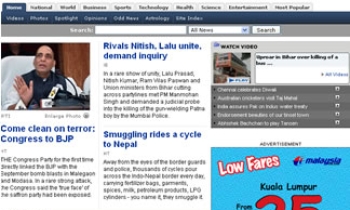Oct. 19, 2005 - Interactive, viral behavior is on the rise–especially among young people. That might sound like a public health warning, but it's just advertising jargon for the new media ads that consumers manipulate in some way and pass along to each other–like a virus.
One of most enticing of this genre allows fans to insert themselves, Zelig-like, into a clip from the movie "Wedding Crashers" from New Line Cinema. Thanks to some snazzy technology, the film's Web site lets viewers "crash the trailer" by uploading digital photos of themselves (or anyone else) so that it looks like they are carousing with stars Owen Wilson and Vince Vaughn.
Visitors to the site have so far created 200,000 personalized trailers since the hit comedy's premier this summer. And New Line reports that the custom trailers got more than three times as many viewings as the official trailer (3.3 million versus 1 million) because people forwarded their masterpieces to friends.
Viral ad experts say that it wasn't just the clever gimmick that made the site a hit. "The Crashers’ trailer wasn't the first time you could post a photo on a Web site, but their [promotion] worked really well because it was so connected to the movie's subject," explains Jeff Benjamin, interactive creative director at Crispin Porter + Bogusky, a Miami-based ad agency.
Though he didn’t work on the "Wedding Crasher" effort, Benjamin is somewhat of a pioneer in the field of interactive ads. He and his agency created the now-legendary Subservient Chicken Web video for Burger King. Anyone who saw this weird spot was tempted to pass it along–complete with the "BK" Burger King logo. Since its Spring 2004 launch, the chicken site has attracted more than 16 million unique visitors, and racked up more than 442 million page views.
The chicken video showed big-name advertisers that lots of people would voluntarily view an ad, repeatedly even, if it was fun and they could do something with it. "The chicken opened up our clients' eyes to the exciting things you could be doing with brand advertising on the Web," says Benjamin. "We'd been doing innovative work like this for years, but this was the first time it was associated with a brand." One of his agency's latest projects is an interactive site for Gap clothing that allows users to put together a virtual self (with different body-type and coloring choices) and then use the online mannequin to try different clothing combos. And, they can share the finished product with online pals as well.
Not only has the public been recruited for viral ad distribution, they've also been enlisted to create ads from scratch. Last year, Converse invited amateur filmmakers to submit videos featuring their colorful sneakers. Thirty or so ads won viewer votes online winning their creators $10,000. GEICO auto insurance announced a similar program on their Web site in September of this year. They are asking fans of their "spokes-lizard" to enter a "Golden Gecko" customer-judged contest by submitting a 15-second video trailer for a movie featuring the creature. Winners in the various categories (comedy, drama, etc.) will get vacations, tech gadgets or other goodies.
The interactive ad industry has gained momentum in tandem with increased high-speed broadband Internet access making it easier for more people to watch online video. Broadband users now make up 42 percent of the U.S. population, up from 36 percent in January 2005, according to a September report by Nielson/NetRatings. And Internet ad revenues are following suit. For the first half of 2005, they were up 26 percent from last year, reports the Interactive Advertising Bureau in New York.
The Web still snags a much smaller percentage than print of total measured U.S. advertising revenues (5.3 percent for the Web versus 23 percent for newspapers and 8.6 percent for broadcast network TV in 2005) according to the Jack Myers Business Report. But newspaper growth has been relatively stagnant, while the Internet and other interactive media continue to have double-digit increases. And this revenue shift is expected to continue. At a September 2005 Advertising Week event, David Verklin, the CEO of Aegis Group's Carat Americas, predicted that over the next three years, advertisers will shift $40 billion collectively out of their TV budgets and into new, digital media.
With online advertising so ubiquitous, it takes more than a clever idea to get consumers' attention. Increasingly, they want to get something in return for their time. Hence, the boom in online and mobile media contests and sweepstakes which are incorporated into various ad categories from streaming video to Web site banners. It's hard to find a product that doesn't offer a chance to win something on the Web–a car, a trip to the Superbowl or an electronic gadget. And to get in the game, all you have to do is hand over some valuable personal information–like your name, mailing address and e-mail. While contests and sweepstakes are not measured separately by the Interactive Advertising Bureau in New York, an online category called "referrals" that includes surveys and some contests jumped from two percent in the first half of 2004 to six percent in the first half of 2005. Mitch Rose, vice president of marketing for PointRoll, a New York-based interactive ad company, estimates that promotions, sweepstakes and coupons represent 14 percent of online ads.
One of the leaders in the online sweepstakes promotions field, with prominent clients like Coca-Cola, Ford and Procter & Gamble, is Detroit-based ePrize. Its founder and CEO, Josh Linkner, explains the phenomenon: "The chance to get something for nothing is core to human nature. In advertising now there has to be a value exchange–if you want the consumer to sit through a product demo or take a test drive, there has to be something in it for them."
Even if consumers are attracted to a site by an "instant win" game, once they get there, they hang around for a surprisingly long time playing other site features like Chevy's choose your fantasy NASCAR racing team activity or designing their perfect running shoe. ePrize has found that users spend five minutes, on average, cruising one of their promotional Web sites. That's a lot of time spent with the company logo only a few feet from their sought-after consumer eyeballs. Compare that to a 30-second TV ad that you might fidget through, or skip entirely with your digital recorder.
Being able to track what customers like in a car or a sneaker, is a prime advantage for Internet advertisers. And because the online contests usually warn that the "prize" will be sent to the mailing address users supply, people are likely to supply accurate contact information as well as their product preferences. "This data becomes like gold to marketers who want to target their ads," says Linkner. And more people use company promo sites every year. ePrize says that about 60 million people will visit their sites this year, almost double the 31.5 million visitors they got last year.
Better yet for advertisers, the voluntary ad-watchers don't just go to a promo Web site once; they will often visit repeatedly. According to Linkner, the average visitor to the ePrize sites returns five to seven times over the 60- to 90-day life of the promotion. "That gives you 25 to 30 minutes in front of your consumer, instead of 30 seconds for a TV ad," he says. But that doesn't mean that TV ads are dead; they will now just be part of a juggernaut of multi-media promotion. "A 30-second (TV) spot used to be enough to sell your product," explains Linkner. "Now, your 30-second spot drives a five-minute Web experience."
So, does this mean that some users are spending longer on an ad Web site than they might watching a sitcom? Sure, especially if they happen to fall in love with an online game. More than 500,000 people registered to play a 2005 Audi car promotion that was part reality show and part online game. "The Art of the H3ist," created by McKinney in Durham, N.C., enticed users to help track a "stolen" Audi around the country over a 90-day period. The campaign proved effective, prompting more than 4,000 consumers to take Audi test drives and it recently won top honors in the Interactive Advertising Bureau's Mixx awards.
Another potent interactive lure is branded downloads. Almost all big movie or TV show sites offer themed mobile phone ring tones, wallpaper, buddy icons, e-cards, screen savers and iPod photos. The "Wedding Crashers"' movie download page even says outright: "Let Wedding Crashers’ take over your life."
And speaking of portable, the next frontier of interactive ads will likely be cell phones and other small electronics. While cell phones seem an obvious target–there are more than 2 billion of them after all–it's hard to predict exactly what the next generation of ads will look like and on which gadget they'll work best. Already, hybrid forms are emerging–consumers are entering promotional contests from their movie theater seats by sending a text message from their cell phones. "The change over the past year has been so rapid with all these devices. It's confounding the market," says Vicki Cohen of Frank N. Magid Associates, an Iowa-based strategic media consultancy. "It is not just the Internet anymore; it's cell phones and MP3 players," she adds. "I can even see iTunes or others doing something like giving you a discount on a song [purchase] if you take an ad." And last week’s release of the new iPod with video could add a new wrinkle to on-the-go advertising.
If this sounds like modern media overload, you can visit the pre-Internet passive ad world at the "Opt In to Advertising's New Age," now at the New York Public Library. The show has hundreds of print, radio, TV and Internet ads from the last century browse-able on four nifty "time machines."
One warning: Even people who grew up in the 70's, and loved iconic TV ads like Life cereal's "Hey, Mikey" spot, might find that watching them without a fast forward or skip button is unbelievably frustrating. Maybe the on-demand age has already rewired our brains. Of course, people who weren't around in the '70s probably think the idea of actually going to a library is silly anyway.









